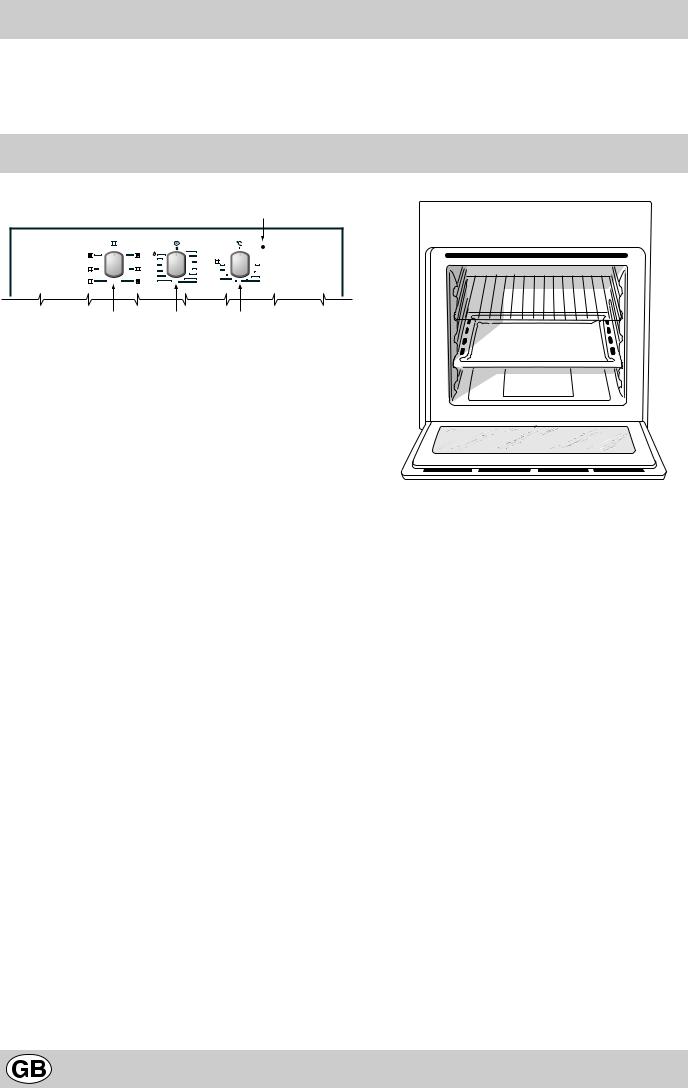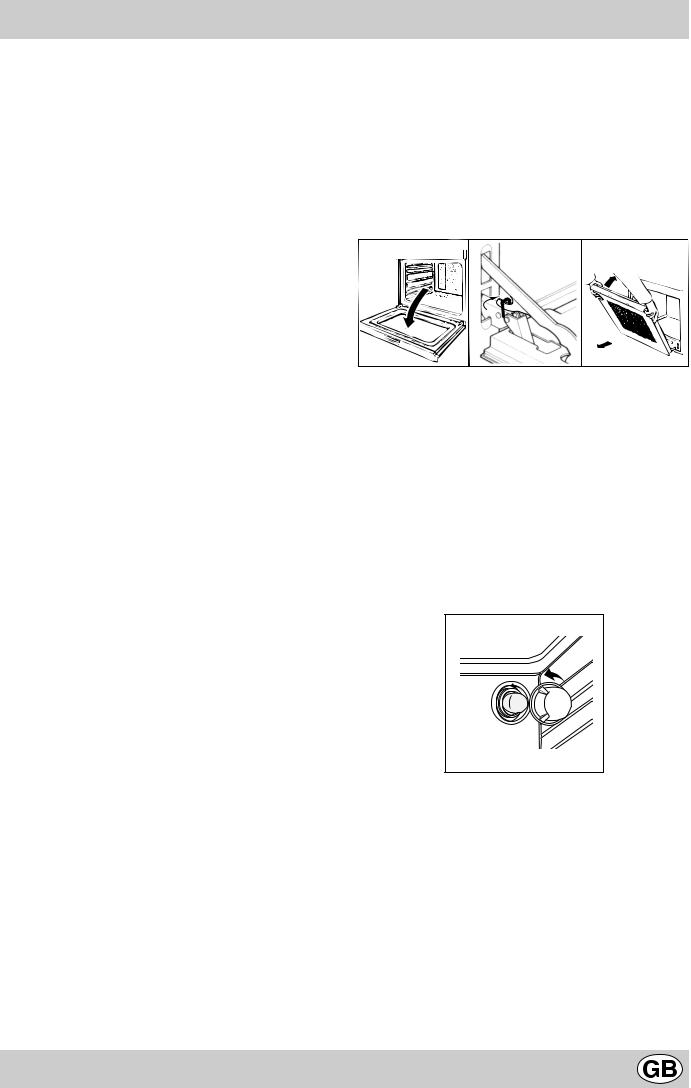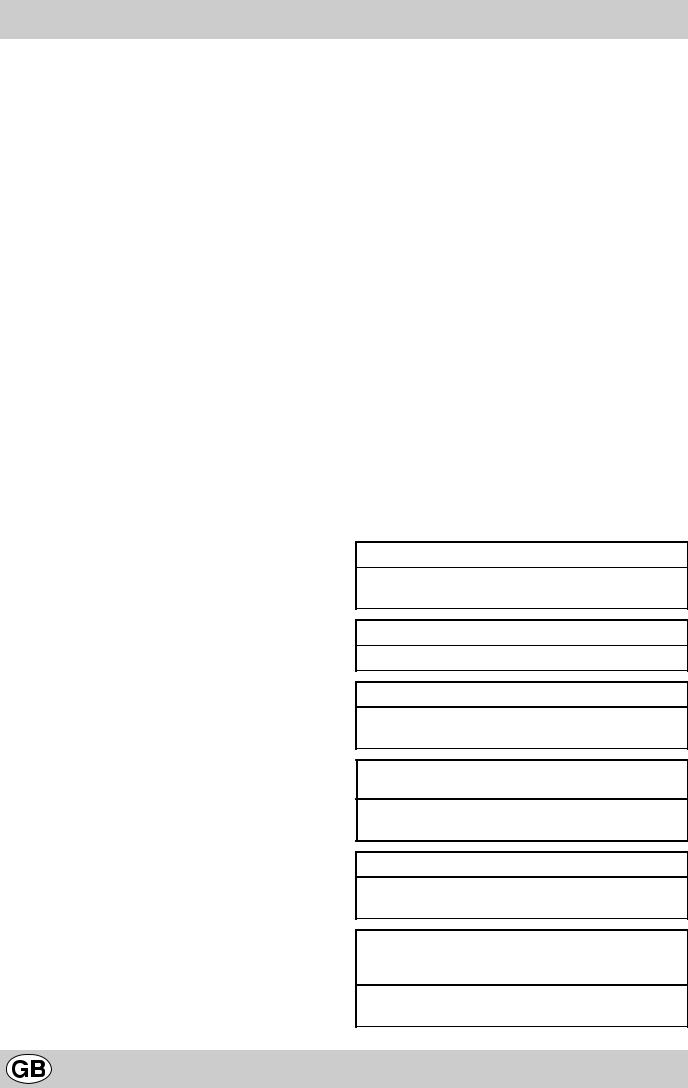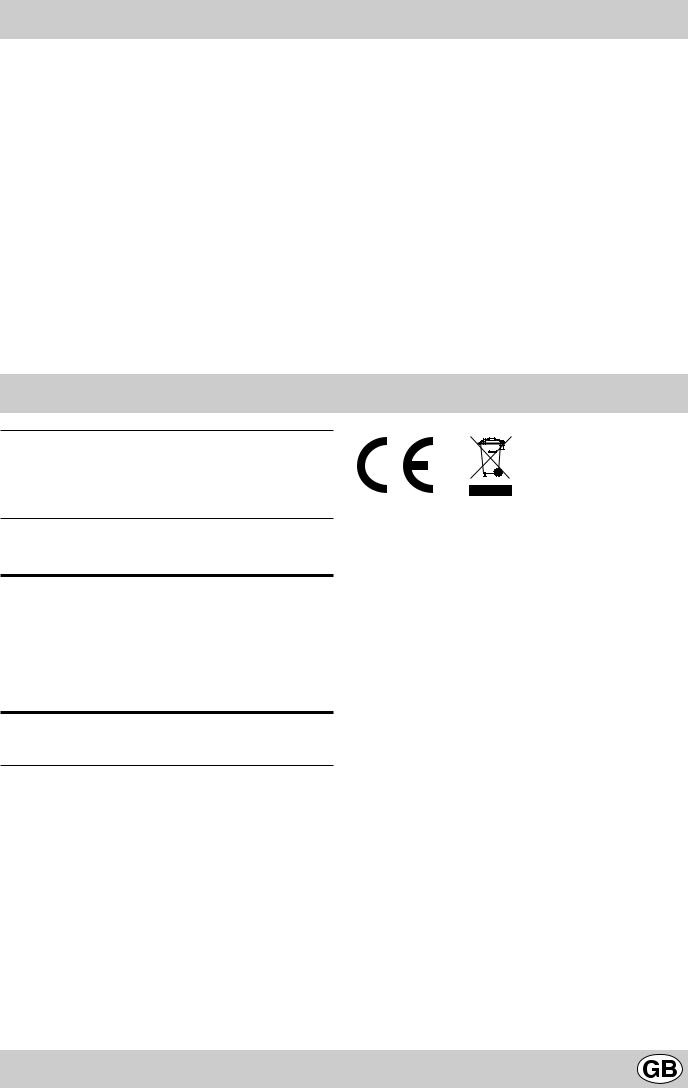Hotpoint CISFD 52.2 Manual

Congratulations on choosing an Ariston appliance, which you will find is dependable and easy to use. We recommend that you read the instructions in this owner’s manual carefully before use for the best performance and to extend the life of your appliance, as it will provide you with all the instructions you require to ensure its safe installation, use and maintenance. Always keep this owner’s manual close to hand since you may need to refer to it in the future. Thank you.
Close-up view
|
|
|
|
E |
|
|
10 |
|
|
|
120 |
20 |
|
|
|
|
|
|
|
|
110 |
30 |
|
|
|
|
MAX |
60 |
|
|
100 |
40 |
220 |
|
|
|
|
|
|
|
90 |
50 |
|
100 |
|
60 |
|
||
|
80 |
180 |
140 |
|
|
70 |
|
||
B |
|
I |
|
C |
A.Control Panel
B.Cooking mode selection knob
C.Cooking temperature selection knob
E.Oven indicator light (only available on certain models) - When lit, it indicates the ovens is heating up to the temperature set.
F.Dripping Pan or Baking Sheet
A 
 H
H
G 
 F
F
G.Oven Rack
H.Guides for sliding the racks or dripping pan in and out
I.End Cooking Time Knob (only available on certain models)
2

How to use your oven
This multi-function oven combines the advantages of traditional convection ovens with those of the more modern fan assisted models in a single appliance.
It is an extremely versatile appliance that allows you to choose easily and safely between 5 different cooking modes. The various features offered by the oven are selected by means of selector knob “B” and thermostat “ C” situated on the control panel.
Notice: The first time you use your appliance, we recommend that you set the thermostat to the highest setting and leave the oven on for about half an hour with nothing in it, with the oven door shut. Then, open the oven door and let the room air. The odour that is often detected during this initial use is due to the evaporation of substances used to protect the oven during storage and until it is installed.
Notice: Place the dripping pan provided on the bottom shelf of the oven to prevent any sauce and/or grease from dripping onto the bottom of the oven only when grilling food or when using the rotisserie (only available on certain models). For all other types of cooking, never use the bottom shelf and never place anything on the bottom of the oven when it is in operation because this could damage the enamel. Always place your cookware (dishes, aluminium foil, etc. etc.) on the grid provided with the appliance inserted especially along the oven guides
Notice: to use the oven in manual mode (not using the end cooking time programmer), the 9 symbol must be aligned with the reference mark on the control panel.
Convection Mode a
Position of thermostat knob “C”: between 60°C and Max. On this setting, the top and bottom heating elements come on. This is the classic, traditional type of oven which has been perfected, with exceptional heat distribution and reduced energy consumption. The convection oven is still unequalled when it comes to cooking dishes made up of several ingredients, e.g. cabbage with ribs, Spanish style cod, Ancona style stockfish, tender veal strips with rice, etc. Excellent results are achieved when preparing veal or beef-based dishes as well (braised meats, stew, goulash, wild game, ham etc.) which need to cook slowly and require basting or the addition of liquid. It nonetheless remains the best system for baking cakes as well as fruit and cooking using covered casserole dishes for oven baking.When cooking in convection mode, only use one dripping pan or cooking rack at a time, otherwise the heat distribution will be uneven. Using the different rack heights available, you can balance the amount of heat between the top and the bottom of the oven. Select from among the various rack heights based on whether the dish needs more or less heat from the top.
Fan Assisted Mode b
Position of thermostat knob “C”: Between 60°C and Max. The heating elements, as well as the fan, will come on. Since the heat remains constant and uniform throughout the oven, the air cooks and browns food uniformly over its entire surface. With this mode, you can also cook various
dishes at the same time, as long as their respective cooking temperatures are the same. A maximum of 2 racks can be used at the same time, following the instructions in the section entitled: “Cooking On More Than One Rack”. This fan assisted mode is particularly recommended for dishes requiring a gratin finish or for those requiring considerably prolonged cooking times, such as for example: lasagne, pasta bakes, roast chicken and potatoes, etc… Moreover, the excellent heat distribution makes it possible to use lower temperatures when cooking roasts. This results in less loss of juices, meat which is more tender and a decrease in the loss of weight for the roast.The fan assisted mode is especially suited for cooking fish, which can be prepared with the addition of a limited amount of condiments, thus maintaining their flavour and appearance.
Desserts: the fan assisted mode is also perfect for baking leavened cakes.
Moreover, this mode can also be used to thaw quickly white or red meat and bread by setting the temperature to 80 °C. To thaw more delicate foods, set the thermostat to 60°C or use only the cold air circulation feature by setting the thermostat to 0°C.
“Top” oven c
Position of thermostat knob “C”: Between 60°C and Max. The top heating element comes on.
This mode can be used to brown food at the end of cooking.
Grill d
Position of thermostat knob “C”: Max
The top central heating element comes on.
The extremely high and direct temperature of the grill makes it possible to brown the surface of meats and roasts while locking in the juices to keep them tender. The grill is also highly recommended for dishes that require a high temperature on the surface: beef steaks, veal, rib steak, filets, hamburgers etc...
Cook food with the oven door ajar.
Some grilling examples are included in the “Practical Cooking Advice” paragraph.
Fan Assisted Grill e
Position of thermostat knob “C”: between 60°C and 200°C. The top central heating element and the fan come on.This combination of features increases the effectiveness of the unidirectional thermal radiation of the heating elements through forced circulation of the air throughout the oven. This helps prevent food from burning on the surface, allowing the heat to penetrate right into the food. Excellent results are achieved with kebabs made with meats and vegetables, sausages, ribs, lamb chops, chicken in a spicy sauce, quail, pork chops, etc.
Cook food in “fan assisted grill mode” with the oven door shut.
This mode is also ideal for cooking fish steaks, like swordfish, tuna, grouper, stuffed cuttlefish etc.
3

End Cooking Time Knob (I) (only available on certain models)
Some models are equipped with a timer program to control when the oven shuts off during cooking.To use this feature, you must wind the “I” knob one full turn in the clockwise direction 4 ;Then, turn the knob in the counter-clockwise direction 5, to set the time by matching up the indicator on the control panel with the number of minutes on the knob.
At the end of the programmed length of time, the timer will sound and automatically turn off the oven.
Attention: to use the oven in manual mode without the cooking control timer, match the indicator on the control panel with the 9 symbol on the timer knob.
When the oven is not in use, the cooking control timer can be used like a normal timer.
The oven light
Set knob “B” to the 8 symbol to turn it on. It lights the oven and stays on when any of the electrical heating elements in the oven come on.
Cooling ventilation
In order to cool down the exterior of the appliance, some models are equipped with a cooling fan which comes on automatically when the oven is hot.
When the fan is on, a normal flow of air can be heard exiting between the oven door and the control panel.
Note: When cooking is done, the fan stays on until the oven cools down sufficiently.
4

How to Keep Your Oven in Shape
Before cleaning your oven, or performing maintenance, disconnect it from the power supply.
To extend the life of your oven, it must be cleaned frequently, keeping in mind that:
•Do not use steam equipment to clean the appliance.
•the enamelled or stainless steel parts should be washed with lukewarm water without using any abrasive powders or corrosive substances which could ruin them; Stainless steel could get stained. If these stains are difficult to remove, use special products available on the market. After cleaning, it is advisable to rinse thoroughly and dry.
•the inside of the oven should preferably be cleaned immediately after use, when it is still warm, with hot water and soap; the soap should be rinsed away and the interior dried thoroughly. Avoid using abrasive detergents (for example cleaning powders, etc…) and abrasive sponges for dishes or acids (such as limescale-remover, etc…) as these could damage the enamel. If the grease spots and dirt are particularly tough to remove, use a special product for oven cleaning, following the instructions provided on the packet.
•if you use your oven for an extended period of time, condensation may form. Dry it using a soft cloth.
•there is a rubber seal surrounding the oven opening which guarantees its perfect functioning. Check the condition of this seal on a regular basis. If necessary, clean it and avoid using abrasive products or objects to do so. Should it become damaged, please contact your nearest After-sales Service Centre. We recommend you avoid using the oven until it has been repaired.
•never line the oven bottom with aluminium foil, as the consequent accumulation of heat could compromise the cooking and even damage the enamel.
•clean the glass door using non-abrasive products or sponges and dry it with a soft cloth.
How to remove the oven door
For a more thorough clean, you can remove the oven door. Proceed as follows:
•open the door fully;
•lift up and turn the small levers situated on the two hinges;
•grip the door on the two external sides, shut it slowly but not completely;
•pull the door towards you, pulling it out of its seat; Reassemble the door by following the above procedures backwards.
1 |
2 |
3 |
Replacing the Oven Lamp
•Disconnect the oven from the power supply by means of the omnipolar switch used to connect the appliance to the electrical mains; or unplug the appliance if the plug is accessible;
•Remove the glass cover of the lamp-holder;
•Remove the lamp and replace with a lamp resistant to high temperatures (300°C) with the following characteristics:
-Voltage: 230/240 V
-Wattage 25W
-Type E14
•Replace the glass cover and reconnect the oven to the mains power supply.
5

Practical Cooking Advice
The oven offers a wide range of alternatives which allow you to cook any type of food in the best possible way. With time you will learn to make the best use of this versatile cooking appliance and the following directions are only a guideline which may be varied according to your own personal experience.
Preheating
If the oven must be preheated (this is generally the case when cooking leavened foods), the “fan assisted” mode bcan be used to reach the desired temperature as quickly as possible in order to save on energy.
Once the food has been placed in the oven, the most appropriate cooking mode can then be selected.
Cooking on More Than One Rack
If you have to cook on more than one rack at the same time, use only the “fan assisted mode” b which is the only one that is appropriate for this type of cooking.
•The oven is fitted with 5 racks. During fan assisted cooking, use two of the three central racks; the lowest and highest racks receive the hot air directly and therefore delicate foodstuffs could be burnt on these racks.
•As a general rule, use the 2nd and 4th rack from the bottom, placing the foodstuffs that require greater heat on the 2nd rack from the bottom. For example, when cooking meat roasts together with other food, place the roast on the 2nd rack from the bottom and the more delicate food on the 4th rack from the bottom.
•When cooking foodstuffs that require differing times and temperatures, set a temperature that is somewhere between the two temperatures required, place the more delicate food on the 4th rack from the bottom and take the food requiring less time out of the oven first.
•Use the dripping pan on the lower rack and the grid on the upper;
Using the Grill
This multi-function oven offers you 2 different grilling modes.
Use the “grill” mode d, with the oven door ajar, placing the food under the centre of the grill (situated on the 3rd or 4th rack form the bottom) because only the central part of the top heating element is turned on.
Use the bottom rack (1st from the bottom), placing the dripping pan provided to collect any sauce and/or grease and prevent the same from dripping onto the oven bottom. When using this mode, we recommend you set the thermostat to the highest setting. However, this does not mean you cannot use lower temperatures, simply by adjusting the thermostat knob to the desired temperature.
Setting e “fan assisted grill”, only with the oven door shut, is extremely useful for grilling foods rapidly, as the distribution of heat makes it possible not only to brown the surface, but also to cook the bottom part.
Moreover, it can also be used for browning foods at the end of the cooking process, such as adding that gratin finish to pasta bakes, for example.
When using this mode, place the grid on the 2nd or 3rd oven rack from the bottom (see cooking table) then, to prevent fat and grease from dripping onto the bottom of the oven and thus smoke from forming, place a drippingpan on the 1st rack from the bottom.
Important: always use the “fan assisted grill” with the oven door shut. This will allow you both to obtain excellent results and to save on energy (approximately 10%).
When using this mode, we advise you to set the thermostat to 200°C, as it is the most efficient way to use the grill, which is based on the use of infrared rays. However, this does not mean you cannot use lower temperatures, simply by adjusting the thermostat knob to the desired temperature.
Therefore the best results when using the grill modes are obtained by placing the grid on the lower racks (see cooking table) then, to prevent fat and grease from dripping onto the bottom of the oven and smoke from forming, place a dripping-pan on the 1st oven rack from the bottom.
Baking Cakes
When baking cakes, always place them in a preheated oven. Make sure you wait until the oven has been preheated thoroughly (the red light “E” will turn off). Do not open the oven door during baking to prevent the cake from dropping. In general:
Pastry is too dry
Increase the temperature by 10°C and reduce the cooking time.
Pastry dropped
Use less liquid or lower the temperature by 10°C.
Pastry is too dark on top
Place it on a lower rack, lower the temperature, and increase the cooking time.
Cooked well on the inside but sticky on the outside
Use less liquid, lower the temperature, and increase the cooking time.
The pastry sticks to the pan
Grease the pan well and sprinkle it with a dusting of flour or use greaseproof paper.
I used more than one level (in the function "ventilated oven") and they are not all at the same cooking point
Use a lower temperature setting. It is not necessary to remove the food from all the racks at the same time.
6

Cooking Pizza
For best results when cooking pizza, use the “fan assisted “ b mode:
•Preheat the oven for at least 10 minutes;
•Use a light aluminium pizza pan, placing it on the grid supplied with the oven. If the dripping pan is used, this will extend the cooking time, making it difficult to get a crispy crust;
•Do not open the oven door frequently while the pizza is cooking;
•If the pizza has a lot of toppings (three of four), we recommend you add the mozzarella cheese on top halfway through the cooking process.
•When cooking pizza on two racks, use the 2nd and 4th with a temperature of 220°C and place the pizzas in the oven after having preheated it for at least 10 minutes.
Cooking Fish and Meat
When cooking white meat, fowl and fish, use temperature settings from 180 °C to 200 °C.
For red meat that should be well done on the outside while tender and juicy in the inside, it is a good idea to start with a high temperature setting (200°C-220°C) for a short time, then turn the oven down afterwards.
In general, the larger the roast, the lower the temperature setting. Place the meat on the centre of the grid and place the dripping pan beneath it to catch the fat.
Make sure that the grid is inserted so that it is in the centre of the oven. If you would like to increase the amount of heat from below, use the low rack heights. For savoury roasts (especially duck and wild game), dress the meat with lard or bacon on the top.
Technical Specifications
Inner dimensions of the oven:
Width 43.5 cm
Depth 40 cm
Height 32 cm
Inner Volume of the Oven:
56 litres
ENERGY LABEL
Directive 2002/40/EC on the label of electric ovens Norm EN 50304
Energy consumption for Forced convection
heating mode: b Fan assisted Declared energy consumption for Natural convection Class
heating mode: a Convection
Voltage and Frequency of Power Supply:
230V ~ 50/60Hz 2250W
This appliance complies with the following European Economic Community directives:
-73/23/EEC of 19/02/73 (Low Voltage) and subsequent modifications;
-89/336/EEC of 03/05/89 (Electromagnetic Compatibility) and subsequent modifications;
-93/68/EEC of 22/07/93 and subsequent modifications.
-2002/96/EEC
The European Directive 2002/96/EC on Waste Electrical and Electronic Equipment (WEEE), requires that old household electrical appliances must not be disposed of in the normal unsorted municipal waste stream. Old appliances must be collected separately in order to optimise the recovery and recycling of the materials they contain and reduce the impact on human health and the environment. The crossed out “wheeled bin” symbol on the product reminds you of your obligation, that when you dispose of the appliance it must be separately collected. Consumers should contact their local authority or retailer for information concerning the correct disposal of their old appliance.
7

|
|
|
|
|
|
|
|
|
|
|
|
|
|
Selector knob |
Food to be cooked |
Weight |
Cooking rack |
Preheating time |
Thermostat |
Cooking |
setting |
|
(in kg) |
position from |
(minutes) |
knob |
time |
|
|
|
bottom |
|
setting |
(minutes) |
|
|
|
|
|
|
|
1 Convection |
Duck |
1 |
3 |
15 |
200 |
65-75 |
a |
Roast veal or beef |
1 |
3 |
15 |
200 |
70-75 |
|
Pork roast |
1 |
3 |
15 |
200 |
70-80 |
|
Biscuits (short pastry) |
- |
3 |
15 |
180 |
15-20 |
|
Tarts |
1 |
3 |
15 |
180 |
30-35 |
|
|
|
|
|
|
|
2 Fan |
Pizza (on 2 racks) |
1 |
2-4 |
15 |
220 |
15-20 |
assisted |
Lasagne |
1 |
3 |
10 |
200 |
30-35 |
b |
Lamb |
1 |
2 |
10 |
180 |
50-60 |
|
Roast chicken + potatoes |
1 |
2-4 |
10 |
180 |
60-75 |
|
Mackerel |
1 |
2 |
10 |
180 |
30-35 |
|
Plum-cake |
1 |
2 |
10 |
170 |
40-50 |
|
Cream puffs (on 2 racks) |
0.5 |
2-4 |
10 |
190 |
20-25 |
|
Biscuits (on 2 racks) |
0.5 |
2-4 |
10 |
180 |
10-15 |
|
Sponge cake (on 1 rack) |
0.5 |
2 |
10 |
170 |
15-20 |
|
Sponge cake (on 2 racks) |
1.0 |
2-4 |
10 |
170 |
20-25 |
|
Savoury pies |
1.5 |
3 |
15 |
200 |
25-30 |
|
|
|
|
|
|
|
3 Top Oven |
Browning food to perfect |
- |
3/4 |
15 |
220 |
- |
c |
cooking |
|
|
|
|
|
|
|
|
|
|
|
|
4 Grill |
Soles and cuttlefish |
1 |
4 |
5 |
Max |
8-10 |
d |
Squid and prawn kebabs |
1 |
4 |
5 |
Max |
6-8 |
|
Cod filet |
1 |
4 |
5 |
Max |
10 |
|
Grilled vegetables |
1 |
3/4 |
5 |
Max |
10-15 |
|
Veal steak |
1 |
4 |
5 |
Max |
15-20 |
|
Cutlets |
1 |
4 |
5 |
Max |
15-20 |
|
Hamburgers |
1 |
4 |
5 |
Max |
7-10 |
|
Mackerels |
1 |
4 |
5 |
Max |
15-20 |
|
Toasted sandwiches |
n.° 4 |
4 |
5 |
Max |
2-3 |
|
|
|
|
|
|
|
|
With rotisserie (where |
|
|
|
|
|
|
present) |
|
|
|
|
|
|
Veal on the spit |
1.0 |
- |
5 |
Max |
80-90 |
|
Chicken on the spit |
1.5 |
- |
5 |
Max |
70-80 |
|
Lamb on the spit |
1.0 |
- |
5 |
Max |
70-80 |
|
|
|
|
|
|
|
5 Fan |
Grilled chicken |
1.5 |
3 |
5 |
200 |
55-60 |
assisted grill |
Cuttlefish |
1.5 |
3 |
5 |
200 |
30-35 |
e |
|
|
|
|
|
|
|
|
|
|
|
|
|
|
With rotisserie (where |
|
|
|
|
|
|
present) |
|
|
|
|
|
|
Veal on the spit |
1.5 |
- |
5 |
200 |
70-80 |
|
Chicken on the spit |
2.0 |
- |
5 |
200 |
70-80 |
|
Chicken (on the spit) + |
1.5 |
- |
5 |
200 |
70-75 |
|
potatoes (roasted) |
- |
2 |
5 |
200 |
70-75 |
|
Lamb on the spit |
1.5 |
- |
5 |
200 |
70-80 |
|
|
|
|
|
|
|
NB: cooking times are approximate and may vary according to personal taste. When cooking using the grill or fan assisted grill, the dripping pan must always be placed on the 1st oven rack from the bottom.
8
